
The Great Migration
Arminda Thomas, Dramaturg, provides historical context for the story of Jazz
May 17, 2017—This mammoth exodus of African Americans from countryside to city and from the South to the North was the largest voluntary internal movement of Black people ever seen. From the end of Reconstruction until the onset of the Depression in 1930, nearly 1.5 million African Americans left the South—fleeing poverty, segregation, rising tides of violence, and the massive collapse of the Southern agricultural system. Stopping first in Southern cities before moving north in waves, migrants sought ostensibly better lives, or at least employment.
Work, or a lack of it, was a major reason for leaving the South.
As the Boll Weevil Infestation devastated the cotton industry (1915–1920), WWI fueled a frenzy of jobs at factories and railroads in the North. Between 1916 and 1918 alone, 400,000 African Americans migrated north. In the summer of 1916, the Pennsylvania Railroad helped more than 10,000 African Americans move—hoping to employ them. The lure of jobs—especially domestic work—drew Black women to the North in greater numbers even than men.

Meantime, new communities sprang up in Northern cities.
Harlem, especially, became a cultural Mecca in the 1920s. As author and activist James Weldon Johnson wrote, “Harlem is not merely a Negro colony or community, it is a city within a city, the greatest Negro city in the world…it occupies one of the most beautiful and healthful sections of the city.” But as Morrison reminds us, behind the alluring glitter of the Harlem Renaissance or the Jazz Age jitterbugging lay the haunting hardships and potential pain of daily life for ordinary folks.




